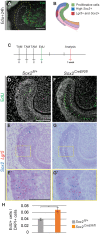Plasticity within the niche ensures the maintenance of a Sox2+ stem cell population in the mouse incisor
- PMID: 29180573
- PMCID: PMC5825875
- DOI: 10.1242/dev.155929
Plasticity within the niche ensures the maintenance of a Sox2+ stem cell population in the mouse incisor
Abstract
In mice, the incisors grow throughout the animal's life, and this continuous renewal is driven by dental epithelial and mesenchymal stem cells. Sox2 is a principal marker of the epithelial stem cells that reside in the mouse incisor stem cell niche, called the labial cervical loop, but relatively little is known about the role of the Sox2+ stem cell population. In this study, we show that conditional deletion of Sox2 in the embryonic incisor epithelium leads to growth defects and impairment of ameloblast lineage commitment. Deletion of Sox2 specifically in Sox2+ cells during incisor renewal revealed cellular plasticity that leads to the relatively rapid restoration of a Sox2-expressing cell population. Furthermore, we show that Lgr5-expressing cells are a subpopulation of dental Sox2+ cells that also arise from Sox2+ cells during tooth formation. Finally, we show that the embryonic and adult Sox2+ populations are regulated by distinct signalling pathways, which is reflected in their distinct transcriptomic signatures. Together, our findings demonstrate that a Sox2+ stem cell population can be regenerated from Sox2- cells, reinforcing its importance for incisor homeostasis.
Keywords: Hierarchy; Incisor; Lgr5; Morphogenesis; Renewal; Sox2; Stem cells.
© 2018. Published by The Company of Biologists Ltd.
Conflict of interest statement
Competing interestsThe authors declare no competing or financial interests.
Figures








Similar articles
-
Sox2 controls asymmetric patterning of ameloblast lineage commitment by regulation of FGF signaling in the mouse incisor.J Mol Histol. 2021 Oct;52(5):1035-1042. doi: 10.1007/s10735-021-10005-1. Epub 2021 Jul 19. J Mol Histol. 2021. PMID: 34279757
-
Bcl11b transcription factor plays a role in the maintenance of the ameloblast-progenitors in mouse adult maxillary incisors.Mech Dev. 2013 Sep-Oct;130(9-10):482-92. doi: 10.1016/j.mod.2013.05.002. Epub 2013 May 30. Mech Dev. 2013. PMID: 23727454
-
Sox2 and Lef-1 interact with Pitx2 to regulate incisor development and stem cell renewal.Development. 2016 Nov 15;143(22):4115-4126. doi: 10.1242/dev.138883. Epub 2016 Sep 22. Development. 2016. PMID: 27660324 Free PMC article.
-
On the cutting edge of organ renewal: Identification, regulation, and evolution of incisor stem cells.Genesis. 2014 Feb;52(2):79-92. doi: 10.1002/dvg.22732. Epub 2013 Dec 14. Genesis. 2014. PMID: 24307456 Free PMC article. Review.
-
Regulation of pituitary stem cells by epithelial to mesenchymal transition events and signaling pathways.Mol Cell Endocrinol. 2017 Apr 15;445:14-26. doi: 10.1016/j.mce.2016.09.016. Epub 2016 Sep 17. Mol Cell Endocrinol. 2017. PMID: 27650955 Free PMC article. Review.
Cited by
-
Plasticity of Dental Cell Types in Development, Regeneration, and Evolution.J Dent Res. 2023 Jun;102(6):589-598. doi: 10.1177/00220345231154800. Epub 2023 Mar 15. J Dent Res. 2023. PMID: 36919873 Free PMC article. Review.
-
The impact of biological variables on cell kinetics and differentiation dynamics in the mouse incisor epithelium.Sci Rep. 2025 Apr 9;15(1):12115. doi: 10.1038/s41598-025-96630-2. Sci Rep. 2025. PMID: 40204805 Free PMC article.
-
Dental Epithelial Stem Cells Express the Developmental Regulator Meis1.Front Physiol. 2019 Mar 12;10:249. doi: 10.3389/fphys.2019.00249. eCollection 2019. Front Physiol. 2019. PMID: 30914971 Free PMC article.
-
Pitx2-Sox2-Lef1 interactions specify progenitor oral/dental epithelial cell signaling centers.Development. 2020 Jun 4;147(11):dev186023. doi: 10.1242/dev.186023. Development. 2020. PMID: 32439755 Free PMC article.
-
Intertwined Signaling Pathways Governing Tooth Development: A Give-and-Take Between Canonical Wnt and Shh.Front Cell Dev Biol. 2021 Oct 29;9:758203. doi: 10.3389/fcell.2021.758203. eCollection 2021. Front Cell Dev Biol. 2021. PMID: 34778267 Free PMC article. Review.
References
Publication types
MeSH terms
Substances
Grants and funding
LinkOut - more resources
Full Text Sources
Other Literature Sources
Medical
Molecular Biology Databases

